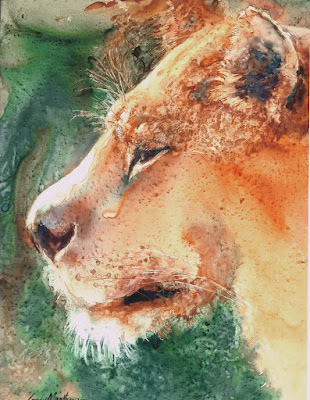 Sliding paint around on YUPO can be compared to the phrase we often hear now --- '''herding cats.''' (Doesn't THAT paint a picture in your mind?)
Sliding paint around on YUPO can be compared to the phrase we often hear now --- '''herding cats.''' (Doesn't THAT paint a picture in your mind?) For this painting, the sliding paint almost worked for the fur on this cat's face. Then the little spot dried between her nose and eye, leaving an unnatural hard edge where I did not want a hard edge. Somehow, for once, I was able to leave that spot alone and go on with the rest of the painting. Trying to correct it after it had dried would've resulted in destroying the beauty of the cheek area.
Once the whole thing was completed, I found that the hard edged spot no longer bothered me. In fact, I liked what it did for the painting.
I also got lucky under her chin where the background color sneaked into the wet paint of her fur, adding just bit cooler look to the shadow there. The grainy area between the ear and the eye is a result of the Lunar Earth separating or granulating in the Quinacridone Burnt Orange area.
If you haven't tried YUPO yet with watercolor, you are missing out on a great adventure. Although this was painted back in 2001, it's still one of my favorite paintings. Fortunately I'd made giglee' prints of it before it sold.
"GRRRRRRR" Transparent Watercolor on YUPO 10 x 12" Collected









